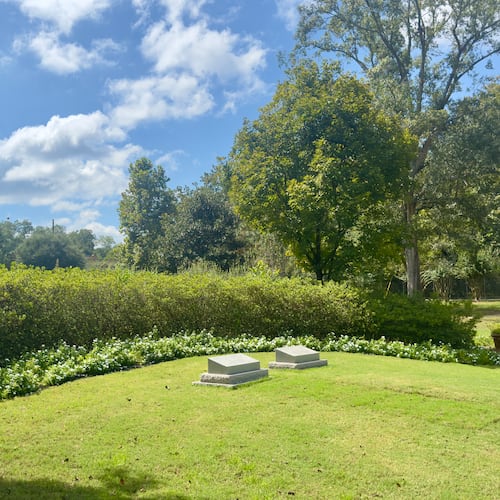BRUNSWICK ― Buc-ee’s courts motorists to its new travel center along I-95 with miles of billboards and a towering yellow sign bearing the cartoon likeness of a bucktoothed beaver.
After dark, the sprawling convenience store and gas station carved from the pine forests of rural Glynn County is even harder to miss — but not because of Buc-ee’s marketing. Instead, a set of 23 high-mast lights operated by the county to help travelers get on and off Exit 42 makes Buc-ee’s stand out like a casino in the Nevada desert.
The mercury vapor beacons have been a flashpoint for public discord since the sea turtle nesting season opened in June. The lights cast what environmental experts call a turtle-disorienting glow for about a dozen miles over Georgia’s low-lying coastal landscape. The glare can reach the nesting beaches of Sapelo Island and Little St. Simons Island and, judging by the winding tracks left by hatchlings as they’ve left the nests this summer, do compete with the natural light that newborns rely on to find the ocean.
Yet the light towers remained on in the name of traffic safety, even as street-level lamps provided new illumination. The Buc-ee’s opened July 1.
The debate entered a new phase in recent weeks. Glynn County commissioners have yet to take action on a Sept. 5 request from state officials to douse the lights during sea turtle hatching season, which ends later this month. Glynn officials asked for documentation that shows the high-mast lights confuse turtle hatchlings, and the state responded Sept. 18 with a 3-page letter detailing the effects of the lighting, citing four published studies.
That evidence is under review by the commissioners, a Glynn spokeswoman said last week, to “ensure the Board (of Commissioners) a complete understanding of the information available before making a decision.”
The county’s pushback has incensed turtle advocates and environmental groups. Georgia’s dramatic recovery in its loggerhead population this century is broadly seen as a point of pride in coastal communities. Residents drive cars with special-issue sea turtle license plates and visitors pose for selfies with turtle-inspired public artwork in places like Tybee Island.
Credit: Photo courtesy of the St. Simons Island Sea Turtle Project and One Hundred Miles
Credit: Photo courtesy of the St. Simons Island Sea Turtle Project and One Hundred Miles
The lights have elicited outcry from locals for 15 months now — since the towers were first illuminated with the start of vertical construction on the Buc-ee’s — and drawn national media attention. Catherine Ridley, director of the St. Simons Island Sea Turtle Project, called Glynn’s continued reluctance to switch the lights off “inexplicable” from a policy standpoint but not out of character for the county government.
Glynn leaders have likewise been slow to revise an outdated lighting ordinance that critics blame for the near absence of sea turtle nesting activity on St. Simons Island. Of the 1,911 nests made on Georgia beaches this summer, only one was on St. Simons.
For comparison, neighboring Jekyll Island, managed by the state, and Sea Island, privately owned and operated, had a combined 222 nests. Both have strict lighting ordinances.
Glynn County has drafted a new law, a revision that began seven years ago. Commissioners are reviewing the ordinance and estimate passage before year’s end.
“No one is asking for no lights at this interchange,” Ridley said. “No one is asking us to prioritize sea turtles safety over human safety. Here we have a simple solution that balances both and has been requested by multiple experts and state agencies and I cannot for the life of me understand why they are digging in their heels and refusing to take action.”
Glynn’s slow movement on the I-95 lights has some critics pointing fingers at Buc-ee’s. They suspect the Texas-based company wants the lights to remain on, a narrative fed by Buc-ee’s refusal to comment or take a position on the lights. A company spokesperson declined to comment on the situation when contacted last week and did not respond to a follow-up communication citing the unfounded allegations and speculation.
The Glynn County spokesperson, Brittany Dozier, says there are “no outside influences or undisclosed factors driving” the county’s review of the lights.
Urgency to extinguish the lights is waning. Only three nests have yet to hatch on the islands affected by the glow, all on Sapelo. Once the last of those hatchlings make their first crawls, the lights won’t be an environmental issue again until next May.
About the Author
Keep Reading
The Latest
Featured




